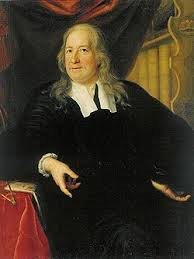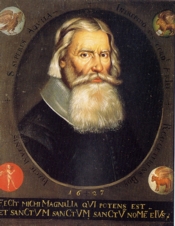Johannes Bureus
Sweden
Sweden was claimed to be the location of Atlantis by Olaus (Olaf) Rudbeck in the 17th century. Before him another Swede, Johannes Bureus, expressed similar views. His friend Carl Lundius supported Rudbeck’s theories, but received none of the acclaim.
In the 18th century Carl Friedrich Baër was happy to follow a fashion, which placed Atlantis in the Holy Land. I am not aware of any major Swedish contribution to Atlantology in the 19th century.*However, the following century saw a number of Swedish researchers make valuable contributions to the subject.*
The discovery of the Mid Atlantic Ridge led René Malaise and Hans Pettersson to suggest the Azores as remnants of Atlantis, an idea still popular today. Around the same time Gunnar Rudberg proposed that Syracuse in Sicily had inspired some of Plato’s description of Atlantis. Arvid Högbom advocated the North Sea as the location of Atlantis in 1915, long before Jürgen Spanuth. In the same region Nils Bergquist opted for the Dogger Bank as has Ulf Erlingsson.
More recently, we seem to have come full circle as Bertil Falk has revived some of Rudbeck’s ideas(a) and a short illustrated 2007 paper (updated 2015)(b) by Robert Fritzius also added some additional modern support. However, for something quite different we have Carl Festin promoting a Mediterranean location.
*Nils-Axel Mörner and Bob Lind, two controversial researchers, have proposed, in a number of papers, that a Bronze Age trading centre existed in southeast Sweden, which had links with the Mycenaeans, Minoans and Phoenicians in the Mediterranean. They suggest that ancient references to Hyperborea may have been generated by this trade. However, although they do not associate Hyperborea with the story of Atlantis, they delivered their theories in papers presented to the Atlantis Conferences of 2008 [750.685] and 2011(c). They also touch on a number of other peripheral subjects including Cygnus, archaeoastronomy and amber. Similar views on early Baltic trade with the Mediterranean have been expressed elsewhere(d).*
(a) https://www.vof.se/folkvett/ar-1993/nr-4/platons-atlantis-diktning-som-tagits-pa-allvar/ (Swedish)
(b) See: https://web.archive.org/web/20100807201746/https://www.datasync.com/~rsf1/vel/atlantis.htm
(c) https://file.scirp.org/Html/1-1140054_59543.htm
Rosicrucians
Rosicrucians were an obscure secret society that emerged in Germany during the 17th century. Nevertheless, earlier individuals have been identified as Rosicrucians such as the Swedish Runic scholar Johannes Bureus (1568-1652) and the alleged founder of the order, John Dee. Some have pushed the beginnings back to the 15th century(b).
Although there are modern ‘Rosicrucian’ groups, the origins of these bodies are rarely traceable beyond the 19th century despite their claims to a lineage that stretches back to ancient Egypt and Atlantis. The basis for such claims is at best imaginary but generally accepted as fraudulent. The Rosicrucians have also been linked with the Holy Grail, a subject that has received greater public interest since the publication of Dan Brown’s The DaVinci Code.
A 1934 extract(c) from the Rosicrucian Digest reveals their thinking at that time.
A 2006 edition(a) of Rosicrucian Digest gives an overview of the search for Atlantis at that point in time.
Lewis Spence, an early 20th-century atlantologist, was a member of a European Rosicrucian order.
>A recent development in Rosicrucian thinking is the idea of extraterrestrial intervention in the affairs of man from early times including our creation – “The knowledge of the Atlanteans came from another galaxy and was brought by those who became the first rulers of Atlantis. Some of these extraterrestrials returned to their home, others remained on earth to carry out a mission, all of the world’s civilizations come from this second group.” Bernard Raymond – L’empire Invisible(d).<
(a) https://www.rosicrucian.org/rosicrucian-digest-atlantis
(b) http://www.unexplainedstuff.com/Secret-Societies/The-Rosicrucians.html
(c) http://rosicrucian.50webs.com/rml/rml-lemuria-legend-or-fact.htm
(d) Rosicrucians’ Secret Knowledge Of Extraterrestrial Visitations – In5D : In5D *
Identity of the Atlanteans *
The Identity of the Atlanteans has produced a range of speculative suggestions nearly as extensive as that of the proposed locations for Plato’s lost island. However, it is highly probable that we already know who the Atlanteans were, but under a different name.
The list below includes some of the more popular suggestions and as such is not necessarily exhaustive. While researchers have proposed particular locations for Atlantis, not all have identified an archaeologically identified culture to go with their chosen location. The problem is that most of the places suggested have endured successive invasions over the millennia by different peoples.
It would seem therefore that the most fruitful approach to solving the problem of identifying the Atlanteans would be to first focus on trying to determine the date of the demise of Atlantis. This should reduce the number of possible candidates, making it easier to identify the Atlanteans.
A final point to consider is that the historical Atlanteans were a military alliance, and as such may have included more than one or none of those listed here. The mythological Atlanteans, who included the five sets of male twins and their successors would be expected to share a common culture, whereas military coalitions are frequently more disparate.
Basques: William Lewy d’Abartiague, Edward Taylor Fletcher
Berbers: Alberto Arecchi, Alf Bajocco, Ulrich Hofmann, Jacques Gossart, Ibn Khaldun
British: William Comyns Beaumont, E. J. de Meester, Donald Ingram, George H. Cooper, Anthony Roberts, Paul Dunbavin.
Cro-Magnons: R. Cedric Leonard, Theosophists, Georges Poisson, Robert B. Stacy-Judd, Kurt Bilau, Louis Charpentier
Etruscans: Richard W. Welch, Frank Joseph *
Guanches: B. L. Bogaevsky, Bory de Saint Vincent, Boris F. Dobrynin, Eugène Pégot-Ogier
Irish: Ulf Erlingsson, George H. Cooper, John Whitehurst, Thomas Dietrich, Padraig A. Ó Síocháin, Lewis Spence,
Maltese: Anton Mifsud, Francis Xavier Aloisio, Kevin Falzon, Bibischok, Joseph Bosco, David Calvert-Orange, Giorgio Grongnet de Vasse, Albert Nikas, Joseph S. Ellul, Francis Galea, Tammam Kisrawi, Charles Savona-Ventura, Hubert Zeitlmair.
Maya: Robert B. Stacy-Judd, Charles Gates Dawes, Colin Wilson, Adrian Gilbert, L. M. Hosea, Augustus le Plongeon, Teobert Maler, Joachim Rittstieg, Lewis Spence, Edward Herbert Thompson, Jean-Frédérick de Waldeck,
Megalith Builders: Lucien Gerardin, Paolo Marini, Sylvain Tristan, Jean Deruelle, Alan Butler, Alfred deGrazia, Helmut Tributsch, Hank Harrison, Walter Schilling, Robert Temple, Manuel Vega
Minoans: K.T. Frost, James Baikie, Walter Leaf, Edwin Balch, Donald A. Mackenzie, Ralph Magoffin, Spyridon Marinatos, Georges Poisson, Wilhelm Brandenstein, A. Galanopoulos, J. G. Bennett, Rhys Carpenter, P.B.S. Andrews, Edward Bacon, Willy Ley, J.V. Luce, James W. Mavor, Henry M. Eichner, Prince Michael of Greece, Nicholas Platon, N.W. Tschoegl, Richard Mooney, Rupert Furneaux, Martin Ebon, Francis Hitching, Charles Pellegrino, Rodney Castleden, Graham Phillips, Jacques Lebeau, Luana Monte, Fredrik Bruins, Gavin Menzies, Lee R. Kerr, Daniel P. Buckley.
Persians: August Hunt, Pierre-André Latreille, William Henry Babcock, Hans Diller.
Phoenicians: Jonas Bergman, Robert Prutz,
Sardinians: Paolo Valente Poddighe, Robert Paul Ishoy, Sergio Frau, Mario Tozzi, Diego Silvio Novo, Antonio Usai, Giuseppe Mura.
Sicilians: Phyllis Young Forsyth, Thorwald C. Franke, Axel Hausmann, Peter Jakubowski, Alfred E. Schmeck, M. Rapisarda,
Swedes: Johannes Bureus, Olaf Rudbeck
Sea Peoples: Wilhelm Christ, Jürgen Spanuth, Spyridon Marinatos, Rainer W. Kühne, John V. Luce, Theodor Gomperz, Herwig Görgemanns , Tony O’Connell, Sean Welsh, Thorwald C. Franke, Werner Wickboldt.
Rudbeck, Olof
Olof (Olaus) Rudbeck, (1630-1702), was a 17th century nationalistic writer from Uppsala, Sweden (a very powerful nation at that time). He was a professor of botany and anatomy,  and was one of two discoverers of the lymphatic vessels. He also had an interest in astronomy, taught mining and fortification theory and was Sweden’s first field archaeologist.
and was one of two discoverers of the lymphatic vessels. He also had an interest in astronomy, taught mining and fortification theory and was Sweden’s first field archaeologist.
Olaf published, Atlantica between 1679 and 1702, in Latin and Swedish [1646], , which placed Atlantis, not altogether surprisingly, in Sweden. This was a massive 2500 page work(b), published with the financial help of the Swedish King Carl XI, in which he offered 102 ‘proofs’ to support his thesis. Atlantica included a map showing Uppsala as Atlantis(a). He also contended that Swedish was the root tongue of all languages!
Rudbeck built his Atlantis theory on a number of details, including references to the Icelandic Eddas.
- He assumed that the mythical Swedish king Atle was the original Atlas,
- He linked the Swedish Atlefjell (Atle’s Mountain) with the Atlas Mountains and an old name for Sweden was Atland, which crops up in the Oera Linda Book,
- He cited Sweden’s large copper deposits as one of his proofs of his country’s identity with Plato’s Atlantis.
It is also of interest that Rudbeck was an early proponent of the idea that the ‘years’ referred to by Plato were in fact originally Egyptian ‘lunar cycles’ and concluded that Atlantis was destroyed circa 1500 BC.
Rudbeck also noted that the Greek word ‘nesos’ could mean ‘island’ OR ‘peninsula’, the latter being applicable to Sweden. He argued that the ‘Pillars of Heracles’ was a designation formerly used to refer to a number of locations. Rudbeck claimed that the Øresund strait between Sweden and Denmark was the site of the Atlantis ‘Pillars’.
It should be noted that Rudbeck’s theory was a development of the earlier ideas of another Swede, Johannes Bureus (1568-1652), a runic scholar, also born near Uppsala.
Half a century after Rudbeck’s death, a fellow Swede, Johannes Jacobi Eurenius, wrote Atlantica Orientalis[1320], published in 1751, in which he placed Atlantis in the Holy Land and argued forcefully against Rudbeck’s Swedish location.
*However, another two centuries were ro pass before a comparably comprehensive study of the Atlantis question was undertaken by Ignatius Donnelly. The passage of time has demonstrated both to be heavily flawed.*
In recent years, Gunnar Eriksson, professor emeritus of the History of Science and Ideas at Uppsala University, published the first Swedish biography of Rudbeck. He also compiled a shorter version, in English[529], that looked at Rudbeck’s 17th century ‘proofs’ that Sweden was Plato’s Atlantis. David King of the University of Kentucky has published[530] a further look at this remarkable, if eccentric, individual.
Stephen P. Kershaw has commented[1410.193] that Rudbeck’s Atlantica ”was written while Lutheran Sweden was still coming to terms with the abdication in July 1654 of ‘Queen of the Swedes, Goths and Vandals’, and her conversion to Roman Catholicism. For the Protestant Rudbeck, the Atlantis project was part of an attempt to champion Swedish nationalism, both politically and religiously; annexing Atlantis, which the Catholic/Mediterranean world had so often used to assert its own supremacy, and moving it to Protestant Sweden was an ingenious move.”
A modern review(c) of Rudbeck’s work by Magnus Alkarp, another Swede, has offered a more generous assessment of his methods, finishing with the following comment – “But leaving aside these dreams of Atlantis, we can simply state that Rudbeck’s hypotheses were rarely aimless fragmentary ideas, thrown out at random. On the contrary, when he combines antiquarian observations with topography, local folklore and written sources Rudbeck becomes a figure of genius – even when he is completely wrong.”
Alfred Nobel, the inventor of dynamite and after whom the annual Nobel Prizes are named, was a direct descendant of Rudbeck.
(b) https://www.journals.uchicago.edu/doi/abs/10.1086/358528
>(c) http://magnus.alkarp.se/essay/the-amazing-discovery-of-atlantis/<
Bureus, Johannes Thomae Agrivillensis
Johannes Thomae Agrivillensis Bureus (1568-1652) was a Swedish  scholar who was one of the first to scientifically study the Scandinavian runes and was greatly involved in the early Rosicrucian movement in Sweden. He believed that Atlantis was the ‘original land’ and that in fact this had been Sweden. This idea was expanded on a few decades later by Olaf Rudbeck, who produced an extensive work on the subject. Bureus is seldom mentioned today in connection with Atlantis.
scholar who was one of the first to scientifically study the Scandinavian runes and was greatly involved in the early Rosicrucian movement in Sweden. He believed that Atlantis was the ‘original land’ and that in fact this had been Sweden. This idea was expanded on a few decades later by Olaf Rudbeck, who produced an extensive work on the subject. Bureus is seldom mentioned today in connection with Atlantis.
